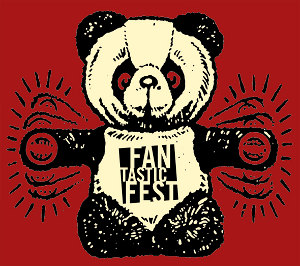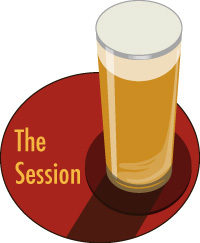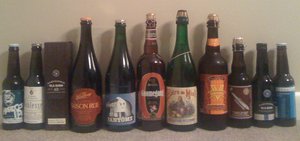As I mentioned yesterday, sometimes my eyes are bigger than my liver. I tend to buy more beer than I drink, so my cellar has been growing of late, and I’ve even started intentionally buying beers to age. In yesterday’s post, I covered what kinds of beers are good for aging. Today, I’m going to list out the beers I’m currently excited to crack open… in a few years. Also some beers I wasn’t intentionally aging, but which will probably have an extra year or so on the bottle before I actually get to it.
- Alvinne The Oak Melchior – Ale brewed with mustard seeds and aged in oak barrels (which were previously used to age Cognac and Calvados Brandy). I’ve actually had this a while, but plan to drink it as soon as it fits in my schedule!
- Anchor Christmas 2011 (x3) – Waiting for next year so that I can do another faux-vertical (and since I have 3, maybe I can continue the tradition a while too).
- Brewdog/Mikkeller Devine Rebel 2009
- Brewdog/Mikkeller Devine Rebel 2010 – Note: This one is actually different than the 2009, even though BA doesn’t have a separate page for it…
- The Bruery Coton – My first taste of The Bruery, and it blew me away. I got another bottle to age…
- The Bruery Cuir (x2)
- The Bruery 4 Calling Birds
- Cape Ann Fisherman’s Imperial Pumpkin Stout
- Dogfish Head 120 Minute IPA 2011 (x3) – This one seemingly breaks a lot of rules for aging beer (it’s pale and hoppy, for instance), but at 18% ABV, it’s still a good candidate (and from what I’ve heard, it ages well).
- Dogfish Head World Wide Stout 2011 (x2)
- Fegley’s Brew Works Rude Elf’s Reserve 2011 (x3)
- Great Divide Chocolate Oak Aged Yeti – I don’t think this one has very long to live…
- Harviestoun Ola Dubh Special Reserve 18
- Harviestoun Ola Dubh Special Reserve 30
- La Trappe Quadrupel Barrique (Oak Aged) – Batch 3, blend of new oak, old port barrel, and old La Trappe Quadrupel barrel aged beer. Exciting!
- Mikkeller Big
BadWorse – Bourbon Barrel Aged Barleywine - Mikkeller Black Tie – Scotch Barrel Aged
- Mikkeller Santa’s Little Helper 2011
- Lost Abbey The Angel’s Share 2011 – Bourbon Barrel Aged
- Lost Abbey Deliverance Ale 2011 – A blend of Bourbon and Brandy Barrel Aged Angel’s Share
- Firestone Walker XV Anniversary Ale – A blend of too many beers to list…
- Founders Breakfast Stout 2011 – I know everyone loves this stuff, but I didn’t care for it. It’s a year old now, and I plan on giving it a little more time, then checking it out to see if the flavors have blended together better for my palate…
- Ommegang Aprhodite
- Port Brewing Older Viscosity 2011 – Just had one of these, would love to try one in a year to see what happens to it…
- Schlafly Reserve Barleywine Style Ale – Bourbon Barrel Aged 2008, so I guess it’s ready!
- Schlafly Reserve Imperial Stout – Bourbon Barrel Aged 2008
- Schloss Eggenberg Samichlaus Bier Helles 2007
- Schloss Eggenberg Samichlaus 2009 (x3)
- Schloss Eggenberg Samichlaus 2010
- Sly Fox Ichor Quadrupel
- Stone Old Guardian 2010
- Victory Dark Intrigue (x9)
- Victory Otto Ale – A smoked dubbel, I found the smokey flavors overwhelming. Perhaps they’ll harmonize with the rest of the beer in time…
- Victory V-Twelve
- Voodoo Big Black Voodoo Daddy
- Weyerbacher Blithering Idiot
Not to mention 3-4 cases of homebrew and a bunch of other beer that’s probably not suitable for aging. I didn’t think I had this much beer sitting around. Yes, I need to get drinking. Hopefully a lot of the above won’t be aged too long, if you know what I mean… I’d say only a handful of the above will really make it long term.

 On the first Friday of every month, there’s a beer blog roundup called The Session. Someone picks a topic, and everyone blogs about it. This month,
On the first Friday of every month, there’s a beer blog roundup called The Session. Someone picks a topic, and everyone blogs about it. This month, 
